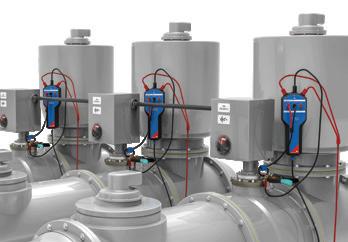
4 minute read
Safely grounded: timing measurements on gasinsulated switchgear
from Energy November 2020
by Monkey Media
SAFELY GROUNDED: TIMING MEASUREMENTS ON GAS-INSULATED SWITCHGEAR by Andreas Nenning, OMICRON Austria
Advertisement
The operating times during C, O, CO, etc., are measured and compared with the manufacturer's reference values for circuit breakers in gas-insulated switchgear (GIS). This allows the condition of the interrupter unit and the operating system to be assessed.
Test sets and the circuit breaker are usually connected by tapping the grounding switches on the switchbay. Due to the low-ohm ground connection resulting from the metallic GIS enclosure that runs parallel to the circuit breaker where both sides are grounded, there is no significant increase in the measured voltage or the resulting resistance at the time of the contact separation. Measuring the operating times is rendered impossible as a suitable resistance threshold value cannot be chosen. Therefore, testing methods such as the dynamic resistance measurement (DRM) cannot be used for measuring the operating times of GIS.
For this reason, timing measurements are often conducted with insulated grounding, or with grounding that is only on one side. Yet this carries the risk of capacitive coupling from adjacent components or switchbay sections on the non-grounded conductor. On-site testing using these methods is often impossible or prohibited in many cases.
Which alternative test methods have been used to date
Test sets that are based on measuring the dynamic circuit breaker capacity (DCM) provide an alternative to tests that are frequently prohibited when grounding is insulated or only done on one side. As a result of installing additional ferrite cores on the grounding switch, the parallel ground impedance can be increased when using the DCM test procedure. However, the assembly and setup is time-consuming. The feasibility of this process is also more restrictive and a variety of ferrite core types are needed, which increases the cost.
Current sensor measurement
CIBANO 500 offers a new, alternative method for measuring operating times in GIS – called the current sensor measurement (CSM) method. The operating time is measured via an inductive current change measurement using the parallel ground connection or the circuit breaker, while the GIS remains grounded on both sides (see Figure 1).
Figure 1. Inductive measurement of the current change with the CSM method.
In order to do this, the circuit breaker is connected to CIBANO 500 via the circuit breaker MC2 accessory (see Figure 2).
Figure 2. Measuring setup of the CSM method.

The circuit breaker MC2 has a constant current source (e.g. IDC = 200A) and a measurement channel for the current sensor. The sensor is laid around the ground connection of the grounding switch (see Figure 3). The current change that is measured through the ground connection or the circuit breaker is then used to determine the switch response times. The circuit breaker remains grounded on both sides throughout the entire measurement.
Figure 3. The current sensor is laid around the ground connection of the grounding switch and connected to circuit breaker MC2.

Advantages of the CSM method
When using this new CSM method, the ground connections on the grounding switch don’t need to be removed and additional components don’t need to be installed. A current sensor just needs to be connected to the switchbay grounding switch. Since these sensors have a flexible design and can easily be installed on a multitude of different grounding switches, they are ideal for on-site applications in GIS installations. Therefore the CSM method is a faster and simpler alternative method for precisely measuring the operating times of a GIS that is grounded on both sides.
Figure 4. The Primary Test Manager™ software shows the results of the timing measurement using CIBANO 500 and the CSM method.

Did you know?
After timing measurements or high residual currents with transient DC components, there may be some residual magnetism left over in the GIS’s current transformer. CIBANO 500 also features the CT Demagnetization function, which quickly and easily demagnetizes the current transformer after timing measurements.
OMICRON is an international company serving the electrical power industry with innovative testing and diagnostic solutions. OMICRON products allow users to assess the condition of the primary and secondary equipment on their systems with complete confidence. Services offered in the area of consulting, commissioning, testing, diagnosis and training make the product range complete. Customers in more than 150 countries rely on the company’s ability to supply leading-edge technology of excellent quality. Service centres on all continents provide a broad base of knowledge and extraordinary customer support. All of this together with our strong network of sales partners is what has made our company a market leader in the electrical power industry. www.omicronenergy.com










